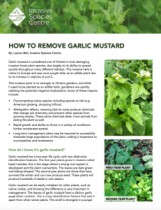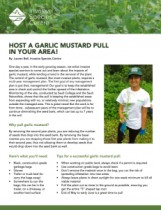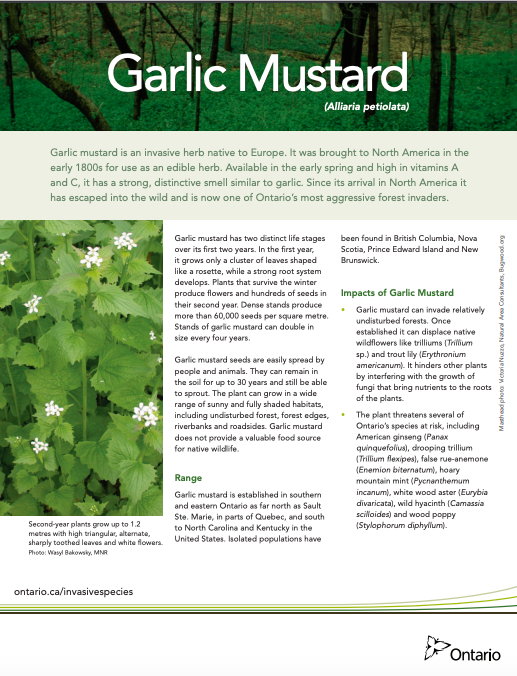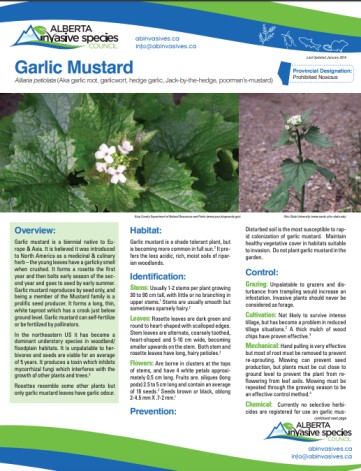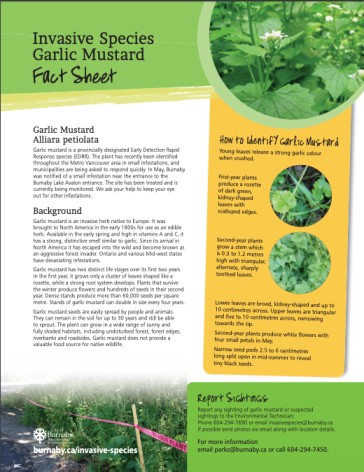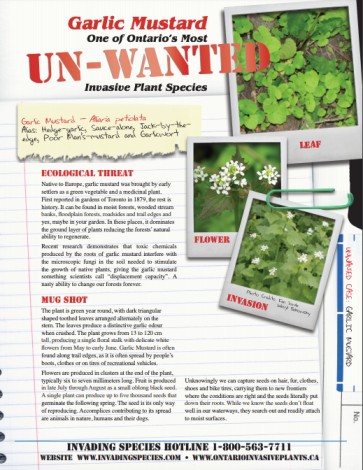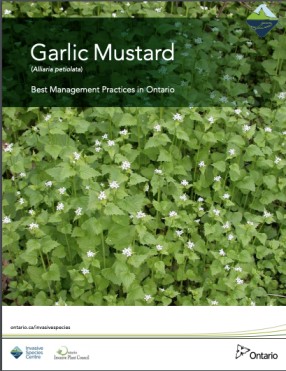Garlic Mustard (Alliaria petiolata)
French common name: Alliaire officinale
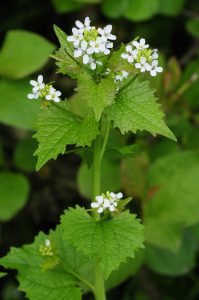
Garlic mustard leaves are dark green and kidney-shaped.
Order: Mustards and allies
Family: Brassicaceae
Did you know? Garlic mustard gets its name from the garlic scent the leaves produce when crushed.
Garlic mustard is an edible herb native to Europe. Since its introduction, garlic mustard has spread throughout Ontario, parts of Quebec, and established populations in western and Atlantic Canada. Garlic mustard is one of Ontario’s most aggressive forest invaders, and threatens biodiversity. Garlic mustard grows in a wide range of habitats and spread quickly along roadsides, trails, and fence lines. Seeds fall close to the parent plants and are rarely dispersed by wind or water. The main pathway for seed spread over long distances is through humans and pets. Within 5-7 years, garlic mustard can enter, establish itself, and become the dominant plant in the forest understory. This is achieved by dispersing chemicals within the soil that prevent the growth of other plants and grasses.
First year plants
Height: First year garlic mustard is low-growing.
Leaves: First year garlic mustard leaves are dark green and kidney-shaped. They have scalloped margins and deep veins that make the leaves look wrinkled. A strong smell of garlic is present when the leaves are crushed.
Roots: First year garlic mustard roots are slender with a white “S” shaped taproot.
Second year plants
Height: Second year garlic mustard grows up to 1 m in height.
Stem: Second year garlic mustard plants have hairy stems.
Leaves: Second year garlic mustard has alternative, 3-8 cm long, triangular, and coarsely-toothed leaves.
Flower: Second year garlic mustard has white flowers, each with four petals. Second year plants flower in early May.
Fruit (seeds): Second year plants have seed pods that are 2.5-6 cm long, each containing 10-20 small black seeds.
Garlic mustard is widespread in Southern Ontario, from Windsor to Ottawa, and has also be found as far north as Sault Ste. Marie. Canada-wide, garlic mustard has been found in BC, Alberta, Ontario, Quebec, New Brunswick, Nova Scotia, and PEI.
Vegetation communities
Garlic mustard does not appear to require disturbance to become established, making it a threat to mature forests. It can enter, establish itself, and become the dominant plant in the forest understory in 5-7 years. It actively displaces native spring ephemeral wildflowers through direct competition and/or through changes to the soil/leaf litter.
Forest ecosystems and wildlife
Garlic mustard is allelopathic; the chemicals produced in the roots have been shown to prevent the growth of other plants and grasses. These chemicals also affect the growth and regeneration of arbuscular mycorrhizal fungi (AMF), beneficial fungi in the soil that help trees and plants absorb nutrients and water into their roots. The reduced AMF in forests inhibits growth of most native tree seedlings and plants, which depend on AMF. Loss of AMF changes the forest ecosystem. Non-native species are able to grow and displace native seedlings, including those which would eventually become canopy trees such as maples and oaks. This effect can last for years after garlic mustard has been removed.
Ontario’s forests have evolved to depend on leaf litter, which provides a layer of slowly decomposing organic matter on the forest floor. Garlic mustard leaves have a high nutrient content. When they die, they accelerate the rate of decay of native leaf litter, altering the natural decomposition cycle and changing the structure and function of forest ecosystems.
This effect is compounded by non-native earthworms which have also caused ecosystem changes to Ontario’s forests by reducing the amount of leaf litter available. Garlic mustard is able to establish itself in these low-leaf litter environments, whereas many native species cannot. By changing the composition of the litter layer on the forest floor, garlic mustard reduces habitat for ground-nesting birds and affects habitat for salamanders and other forest floor-dwelling animals.
Mechanical Control
Hand pulling: Hand pulling is a viable strategy for small populations or few plants. Hand pulling garlic mustard will create soil disturbance, which stimulates the germination of seeds in the seed bank. The entire “S” shaped root must be removed to avoid resprouting from buds on the root system. Hand pulling must be repeated more than once and is more likely to be successful when followed with replanting with native species.
Basal cutting/mowing: Basal cutting involves cutting 2nd year plants at the base of the stem. The best time to do basal cutting is just after the plants flower and before they produce seeds. Garlic mustard plants can flower at different times, so it may need to be repeated more than once in a season. Basal cutting is preferable to hand pulling because it reduces the soil disturbance. Plants that have been mowed can still send up flowering stalks, but continuous mowing throughout the growing season can prevent seed production.
Clipping flower heads: Clipping the flower heads will prevent seed production but must be repeated continually until the end of the growing season, as it encourages new flowers to emerge.
Chemical Control
For more information on chemical control see the Best Management Practice on Garlic Mustard (below).
Disposal
Do not compost garlic mustard. Any plant materials should be placed in black garbage bags or yard waste bags. Seal the bags tightly and leave them in direct sunlight for about a week. Solarization of the bags kills off any viable plant material. Pulled plants which have flowered are still able to produce seeds, so plant pieces should be removed from the site and either dried and burned or sent to the landfill.
Learn how to identify garlic mustard and other invasive plants, and how to effectively manage these species on your property. See The Landowner’s Guide to Controlling Invasive Woodland Plants. Go to ontario.ca/invasivespecies, click on Here’s a list of things you can do to help fight invasive species, and click on the title (Garlic Mustard MNR):
- Avoid using invasive plants in gardens and landscaping.
- Buy native or non-invasive plants from reputable garden suppliers. Native plants provide habitat and food sources for native wildlife. See Grow Me Instead: Beautiful Non-Invasive Plants for Your Garden.
- Dispose of invasive plants in the garbage. Do not put them in the compost or discard them in natural areas. Discarded flowers may produce seeds.
- When hiking, prevent the spread of invasive plants by staying on trails and keeping pets on a leash.
- If you’ve seen garlic mustard or other invasive species in the wild, please contact the Invading Species Hotline at 1-800-563-7711 or visit www.invadingspecies.com to report a sighting.
Technical Bulletins
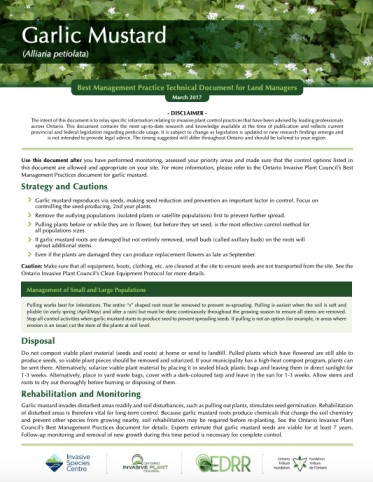
In 2017, the Early Detection & Rapid Response Network worked with leading invasive plant control professionals across Ontario to create a series of technical bulletins to help supplement the Ontario Invasive Plant Council’s Best Management Practices series. These brief documents were created to help invasive plant management professionals use the most effective control practices in their effort to control invasive plants in Ontario.
*Please note: the Invasive Plant Technical Bulletin Series is currently undergoing some updates and will be reposted when the process has been completed. Please visit the Ontario Invasive Plant Council website for updates.
Fact Sheets
Best Management Practices
This Best Management Practices provide guidance for managing invasive Garlic Mustard in Ontario. Funding and leadership for the production of this documents was provided by the Ontario Ministry of Natural Resources (OMNR). The BMPs were developed by the Ontario Invasive Plant Council (OIPC), and its partners to facilitate the invasive plant control initiatives of individuals and organizations concerned with the protection of biodiversity, agricultural lands, infrastructure, crops and natural lands
Research
Allelochemicals Isolated from Tissues of the Invasive Weed Garlic Mustard (Alliaria petiolata)
woodlands and degraded habitats in the eastern United States and Canada. Several
phytotoxic hydrolysis products of glucosinolates, principally allyl isothiocyanate (AITC) and …
Competitive Ability of Alliaria petiolata (Garlic Mustard, Brassicaceae), an Invasive, Nonindigenous Forest Herb
that is currently invading forested areas throughout portions of the northern United States
and southern Canada. Alliaria petiolata enters plant communities in an aggressive fashion …
The invasive plant Alliaria petiolata (garlic mustard) inhibits ectomycorrhizal fungi in its introduced range
effects of invasive plants on EM fungal communities have not been assessed. In this study,
we tested whether the non‐mycorrhizal herbaceous plant Alliaria petiolata (garlic mustard) …
Molecular evidence for multiple introductions of garlic mustard (Alliaria petiolata, Brassicaceae) to North America
this context, molecular markers play an important role because they provide information
about pathways of introduction, the amount of genetic variation introduced, and the extent to …
Impacts of garlic mustard invasion on a forest understory community
Eurasian biennial Alliaria petiolata (garlic mustard), we conducted a vegetation census at
twenty-four plots ranging from low to high invasive cover, and experimentally removed 0, 50 …
Current Research and Knowledge Gaps
Lorem ipsum dolor sit amet, consectetur adipiscing elit. Ut elit tellus, luctus nec ullamcorper mattis, pulvinar dapibus leo.
Further Reading
The Invasive Species Centre aims to connect stakeholders. The following information below link to resources that have been created by external organizations.

